Seven Questions Over Lunch with Viviane Schwarz
 March 14th, 2017 by jules
March 14th, 2017 by jules
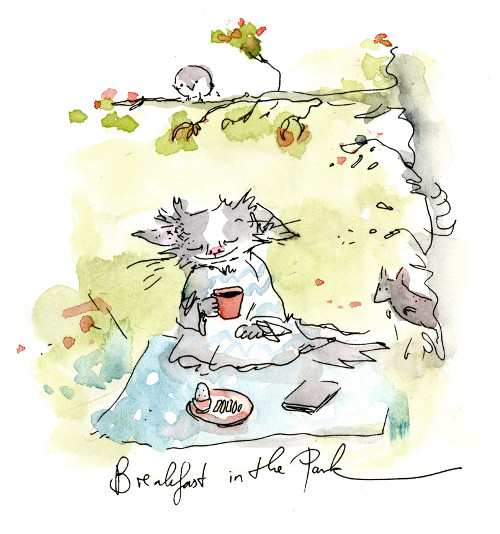
Although I’ve featured art from her books over the last several years, the last time British author-illustrator Viviane Schwarz visited was 2009. (That was fun.) It’s a pleasure to have her visit today for some coffee. We’re having lunch, not breakfast, because I had a slow start to my day. But we’ll still have coffee, while she shows me some of her art, because she’s a fan. “I have one cup of black coffee,” she said when I asked her about breakfast, “on the sofa, watching whatever black-and-white movie is on. That is a good breakfast. An excellent breakfast is when it’s sunny, and I have time to cook up eggs and marmite soldiers and take them into the park to eat under a tree.”
I had to look up what marmite soldiers are, but I fully approve. I also approve of going to the park. (Right about now, I wish this weren’t a cyber-breakfast and that we were really heading outside.) And I think that what was once going to be breakfast would still serve as a great lunch.
Not only do I enjoy Viviane’s books and her artwork, but I enjoyed reading many of her responses today. I thank her for sharing art in this interview — and for creating some of the pieces, such as the one above, specifically for her 7-Imp visit.
Let’s get to it. ….
Jules: Are you an illustrator or author/illustrator?
Viviane: Artist. Although “Author” is important as well. Often I’m “collaborator.” I’m pure “Illustrator” quite rarely. There are usually things I need to invent that aren’t illustrations.
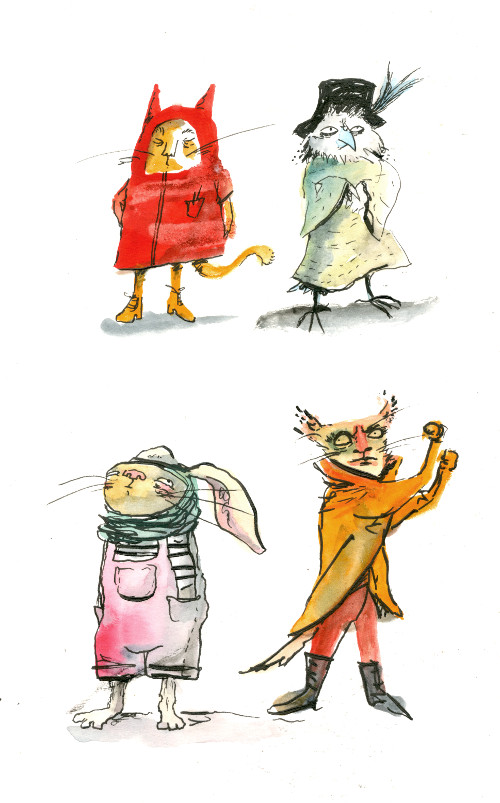
Jules: Can you list your books-to-date?
Viviane:
- Timothy and the Strong Pajamas
- Shark and Lobster’s Amazing Undersea Adventure
- There are Cats in This Book
- There Are No Cats in This Book
- Is There a Dog in This Book?
- A Place to Call Home
- Cheese Belongs to You!
- The Sleepwalkers
- Welcome to your Awesome Robot
- How to Find Gold
- I Am Henry Finch
- Counting with Tiny Cat
Jules: What is your usual medium?
Viviane: I like to build with cardboard …
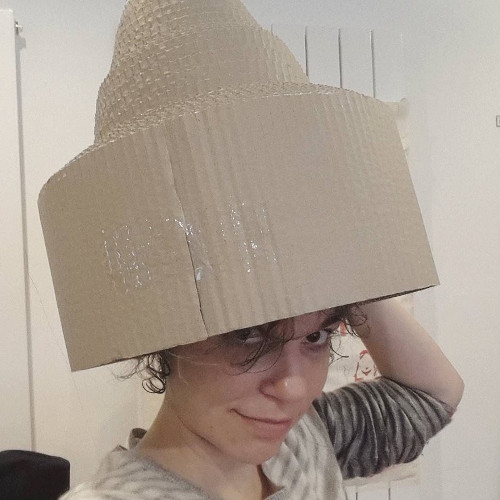
… and to write on my laptop and to draw with Blackwing Pencils and ink. Ink is my favourite medium of all. I always have ink-stained hands. I use a collection of flexible fountain pens and dipping nibs. I make my own inking implements from animal hair, plants, twigs, feathers. I have a nice scratchy nib made from a bird’s foot and a set of brushes made from clippings from people’s pets that they sent me. So far, horse hair suits me best. Then, goat.
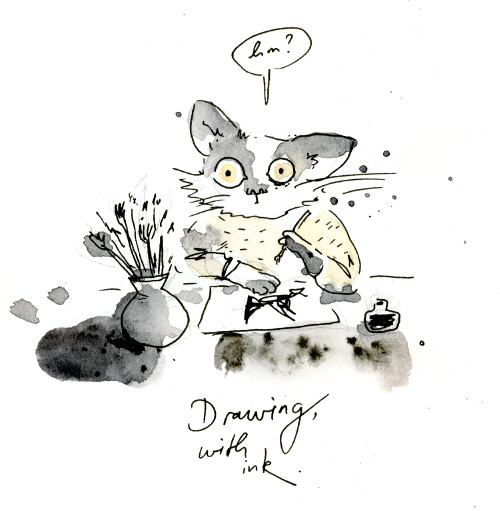
Jules: If you have illustrated for various age ranges (such as, both picture books and early reader books OR, say, picture books and chapter books), can you briefly discuss the differences, if any, in illustrating for one age group to another?
Viviane: It feels like the people who care most about matching style to age are parents trying to buy appropriate books, so I did try to signal a bit “this is for little children, so it’s very chunky and primary coloured” and “Look, this is a bit more fiddly, for slightly older children.” But it turns out adults really like the simple stuff, and toddlers often go for the more complicated style. I do what fits the world of the book without thinking about age too much. We’re all people with different tastes, whatever age, and it’s good for us to be confronted with a wide range of stuff all through life, not just with what we like best already.
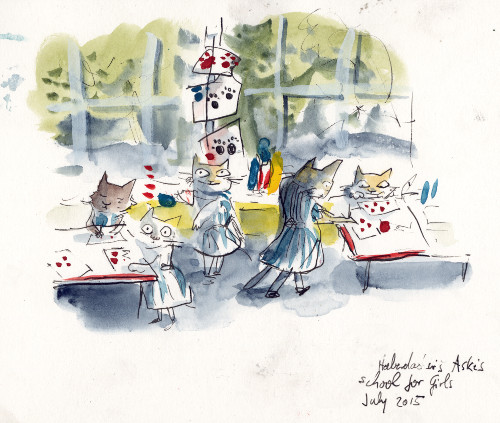
Jules: Where are your stompin’ grounds?
Viviane: I live in South London. It’s very busy and ridiculously expensive, but after a decade here I have finally found a place I love that has trees and a cat and a good space for my desk.
I often go out for walks. I love London. In other places (including Germany), the first question people ask me is: Where are you from? It’s an odd question to keep answering somewhere you lived half your life.
In London, people ask me: What do you do? And they are usually happy if I don’t ask them where they are from either. We are from everywhere. I like that a lot.
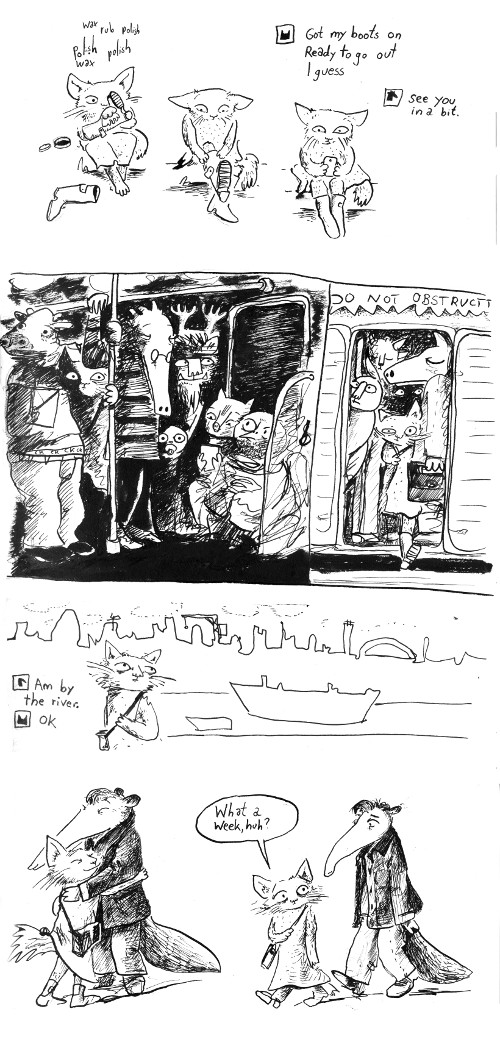
Jules: Can you briefly tell me about your road to publication?
Viviane: I’ve been determined to make books, since I found out that it is a job, and I have always drawn a lot, made inventions, and thought up stories and games. My first published piece was a comic in a children’s magazine when I was thirteen. When I left school, I couldn’t find a specialised illustration course in Germany, so I emigrated. I studied at Falmouth College of Arts and made contact with London publishers from there.
Jules: Can you please point readers to your web site and/or blog?
Viviane: www.vivianeschwarz.co.uk is my main website. vivianeschwarz.blogspot.com is my blog, but @vivschwarz at Twitter is where you can follow me day-to-day. Catandbag.org is a web comic I am drawing about anxiety.
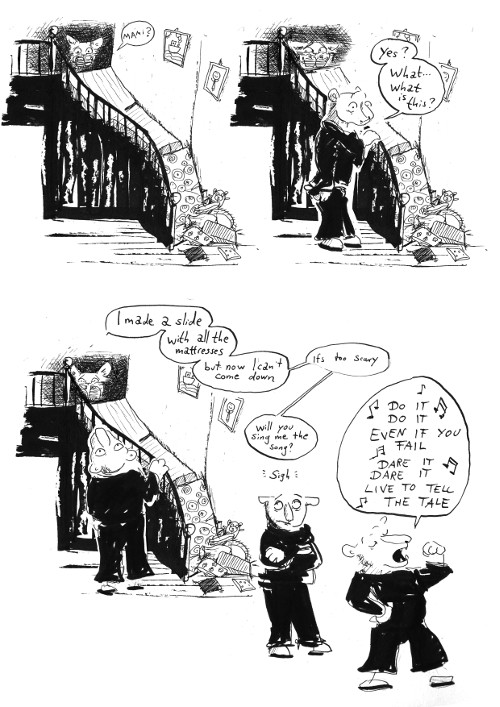
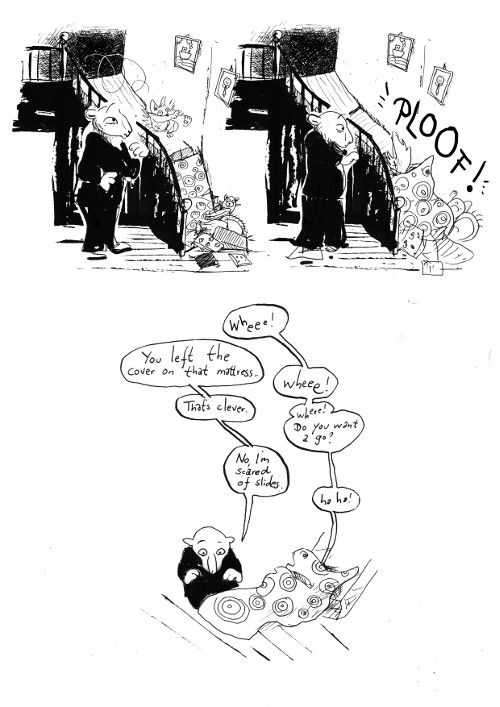
Jules: If you do school visits, can you tell me what they’re like?
Viviane: I usually start by reading them a book, then do some drawing on a flipchart to do with it. I ask the children what to draw, and we create a scene together. Sometimes I bring a suitcase full of paintboxes and a big roll of paper, so we can paint together. I imported a load of paints of the same sort I used when I was in school. They are really good, made by Pelikan. The standard UK school paints are tiny chalky watercolours that just look pretty and polite, even if you paint a massive screaming dinosaur with lasers on. They make me very cross.
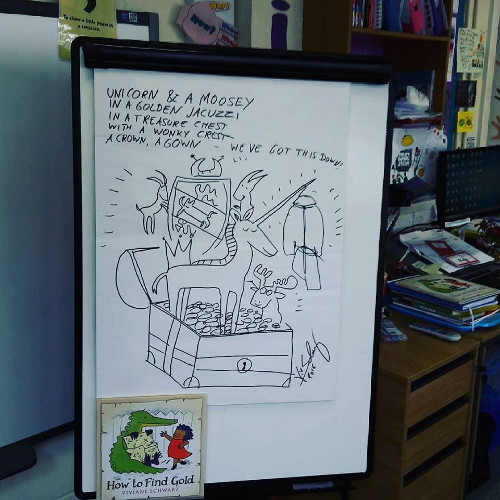
I’ve worked out a way to improvise a huge picture book with a class of children on the spot — on a long roll of paper that I fold into a book and read to them in the end. Then it goes to the school library — with a glowing review by the librarian, hopefully.
A well-prepared school visit is brilliant fun. I’ve mostly been visiting schools that had staff training from the Centre for Literacy in Primary Education recently, and they are a joy to work with. They help the teachers to get the best out of a visit, so they can tie it into their curriculum and put it in context as education rather than entertainment. Big props to them. They have had a huge positive impact on UK school visits already.

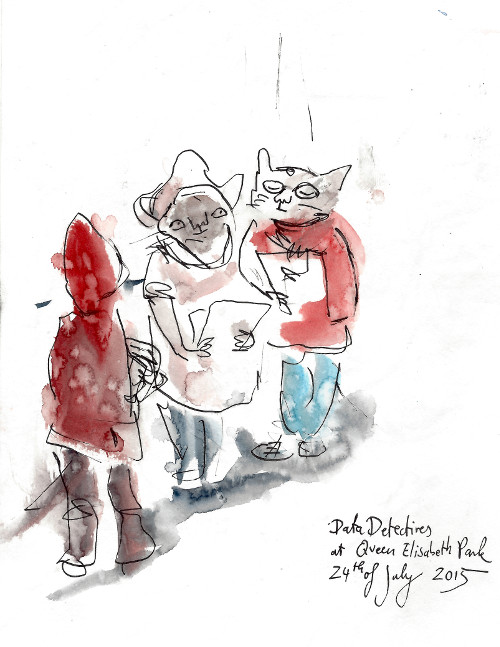
Jules: If you teach illustration, by chance, tell me how that influences your work as an illustrator.
Viviane: I do sometimes teach illustration at University. It’s a great way of teaching myself at the same time. If I tell the students something that sounds clever but actually makes no sense, it’ll show in their artwork right away, and I can apologise and never say it again. Without them, I’d believe a lot of nonsense for a lot longer. I did a 24-hour comic drawing session with the students some time ago. We all set up in a museum and drew a 24-page comic each in 24 hours. I learned a lot doing that, both from drawing the comic and from working alongside other people that way.

I really enjoy seeing families work together, and it feels like a great thing to facilitate that, so I like to do family workshops. When I see parents take everything out of their children’s hands to neaten it up, I try to stop them in a kind and encouraging way and not be cross. The parents need more guidance than the children, because they hold so much responsibility. You need to be nice and not make them look silly when they don’t know how to do something. It’s more important to me that they feel the power of making something real than that it’s a perfect result. Ideally, I want them to go home and make more things, not just frame up whatever they made with me.
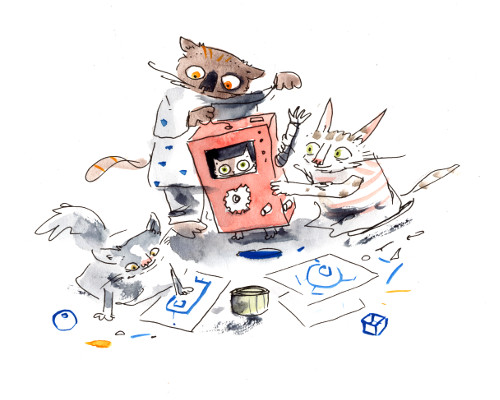
I also sometimes do workshops for primary school teachers under the CLPE Power of Pictures programme. The aim is to give them more confidence to do creative writing exercises and use picture books. It’s inspirational. The teachers are extremely dedicated, excited, curious, and critical. They really want to get the best out of the system they must adhere to. I used to just ignore what teachers might make of my books and how to use them with groups and in schools, because I was rather fed up with the state of early education, but I am happy to say that I’ve learned from them, too. Teachers are awesome. I am honored to be on their team some of the time.
Jules: Any new titles/projects you might be working on now that you can tell me about?
Viviane: How to Find Gold came out last year, a book about two adventurers (Anna and Crocodile), who decide to find gold — and succeed. [Art from that is pictured immediately below.] Those two have become like friends to me, and I often think of them and what they’d be up to right now, so I’ve just finished writing a sequel.

‘That would be dangerous and difficult,’ said Crocodile.
‘Good!’ said Anna. ‘Let’s go!'”
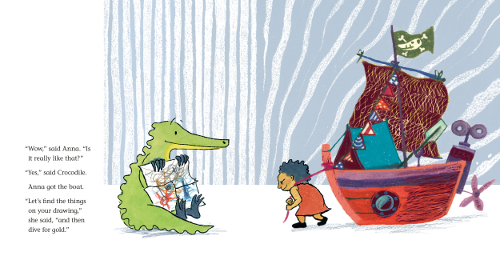
‘Let’s find the things on your drawing,’ she said, ‘and then dive for gold.'”
(Click to enlarge spread)
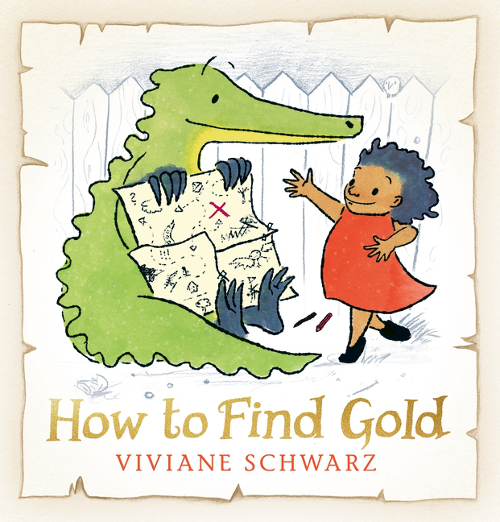
And this very month, one of the cats from my earlier books got their own series. The first book, Counting with Tiny Cat, is out now. [It releases in the U.S. this July.] It is very simple, but I think it’s funny. And silly and strangely useful. The whole series will be all about Tiny Cat teaching us things without quite understanding how they work — but with great enthusiasm.
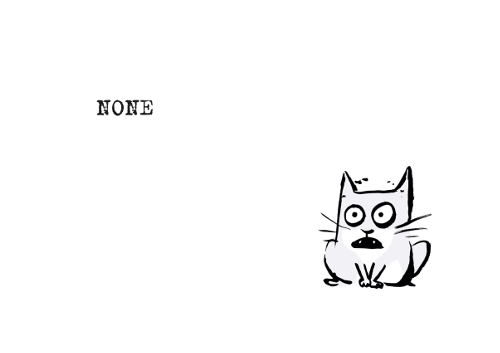
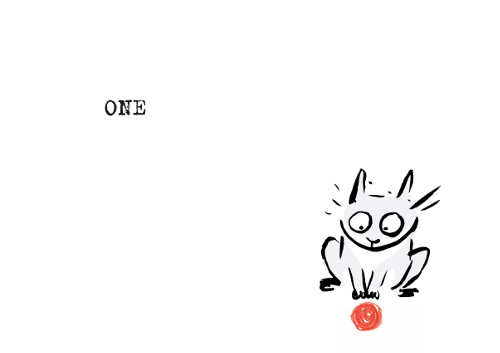
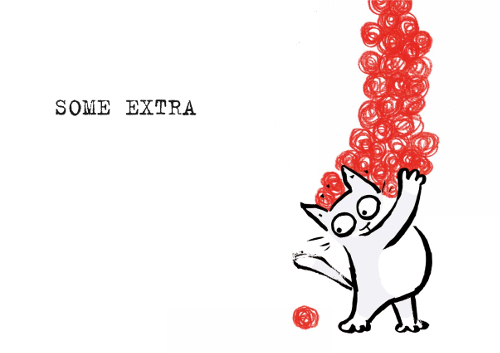
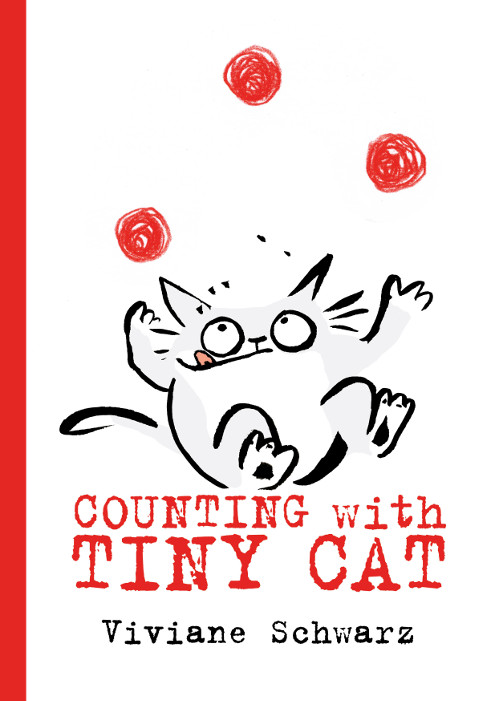
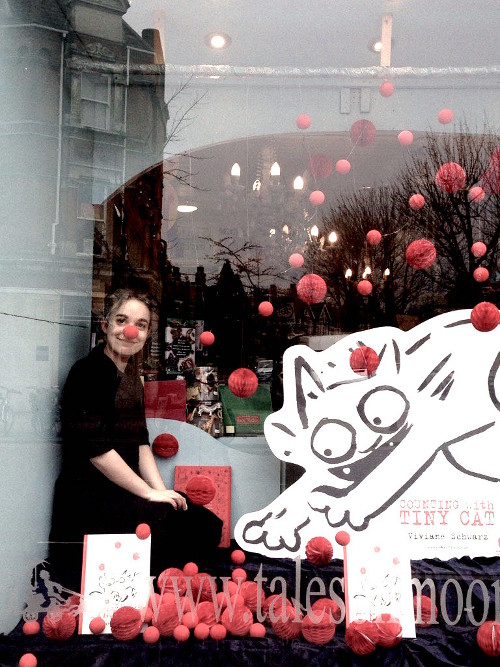
 Okay, we’ve got our coffee, and it’s time to get a bit more detailed with seven questions over breakfast. I thank Viviane again for visiting 7-Imp.
Okay, we’ve got our coffee, and it’s time to get a bit more detailed with seven questions over breakfast. I thank Viviane again for visiting 7-Imp.
1. Jules: What exactly is your process when you are illustrating a book? You can start wherever you’d like when answering: getting initial ideas, starting to illustrate, or even what it’s like under deadline, etc. Do you outline a great deal of the book before you illustrate or just let your muse lead you on and see where you end up?
Viviane: The illustrations always come last. Most often, I have a notion about what I want the book to be good for, first of all. Examples would be: A book that is like a pet you can play with. A book that is a game. A book that helps with nightmares. There is a growing, changing list of these that I carry in my head since childhood: Books that I want to exist.
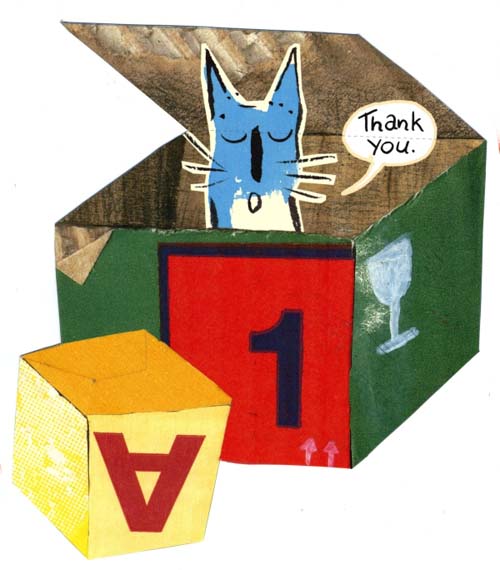
Every so often, I suddenly realise that one of these books fits with something I’ve just noticed or understood, maybe while walking around London or talking to a friend. Next, I think about what sort of book it needs to be — what size, what medium. I imagine reading it. I wonder who would live in that book. At that point, the characters start to arrive.
I draw the characters in the sketchbook I always carry — actually, a bundle of slim sketchbooks and notebooks that I bound into a leather sleeve, one for each thing I’m working on. I sketch them simply, not considering style or finish. They interact. They develop through dialogue, find their stance, develop notions. I use improvisation techniques that mostly come from theatre. I make them argue, see if they will forgive one another, change their status, give them secret needs, make them be boring to see if they become more interesting. They go through many changes, while I try to be honest with myself and not let them settle until I feel that they are real.
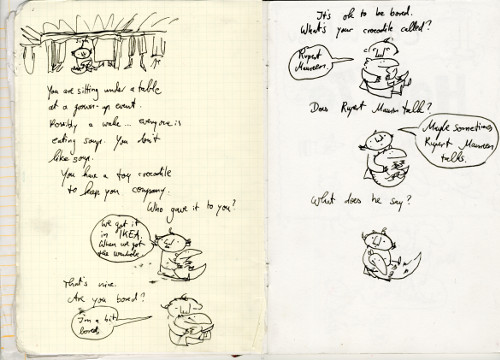

(Click each to enlarge)
I won’t make any book that I don’t completely, honestly believe in. I love every single one of my characters in some way. That doesn’t mean that I approve of everything they do at all times. The love I feel for them is that of seeing something that is alive and reacting to the world. I keep notes about the story and allow it to change with the characters.
It’s not easy getting a book contracted. Publishers hardly ever hand out contracts for ideas any more; they expect a full, presentable dummy. It’s a lot of work to get to that point, every time. By the time I get a contract, most often it’s just a question of finishing the illustrations and honing the text a little. I make sure I always do some other projects—toy camera photography, songwriting, novel drafts, comics—that can run on their own pace so that the ups and downs of making picture books don’t get to me. Those projects usually feed into the books, but that’s not their main purpose.
I do a lot of digital work, and I love computers, but I need to use analogue materials as well to feel connected to the world. If I don’t, I get sad.
2. Jules: Describe your studio or usual work space.
Viviane: I have a very large desk in the lounge. It needs to be, because of the digital set-up which takes up more space than the drawing. I have a massive old Cintiq tablet embedded into the desk. (I built that myself, as I did most of my studio furniture over the years.)
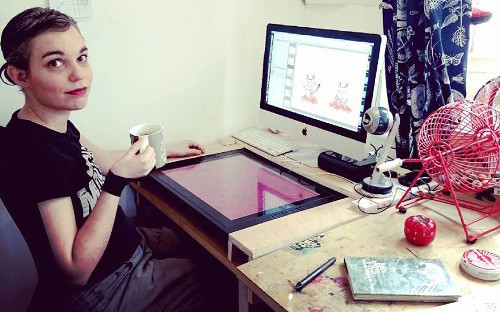
Every so often I go to a café to draw comics. For some reason, the comics need to be drawn in a café — maybe because they are usually about anxiety attacks, and it’s reassuring to be in a friendly place with other people, with nothing else to do at all, and to be brought tea and snacks. I generally go out to do work that I can do away from home. I like to research in the British Library, take long walks with a friend and talk about ideas, or walk alone and just think.
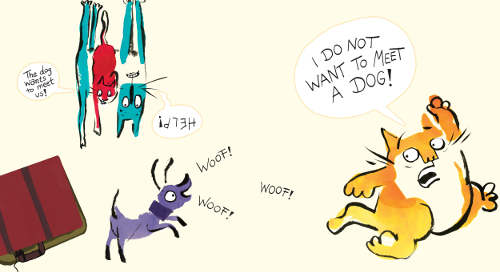
(Click to enlarge)
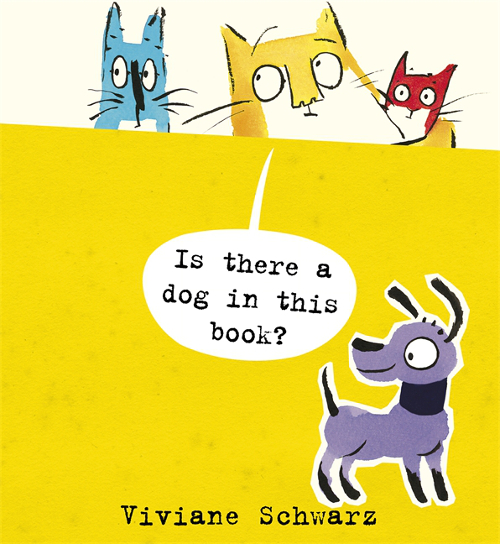
3. Jules: As a book-lover, it interests me: What books or authors and/or illustrators influenced you as an early reader?
Viviane: Most of the names of authors I was aware of as a child are German — F. K. Waechter, Simon and Desi Ruge, Erwin Moser, Michael Ende. Astrid Lindgren was the greatest human being I could imagine, except for Tove Jansson. I was in love with their worlds and their stories.
But just as important was the family collection of nonfiction books: craft books, encyclopedias, volumes about science and natural history. I especially remember The How and Why Wonder Books. The one about the microscope was my favourite, followed by the one about time. I read everything I could get my hands on — books for adults, books for children, instructional booklets, magazines, everything. I could read before anyone realised, so no one bothered to take away adult crime novels or books on child psychology. Everyone thought it was funny and cute that I held them upside down. I just found that reading upside down made the books last a bit longer.
My mother used to take me to the library very often, and I took out as many books as I could carry every time — picture books at first, then novels. The library became my favourite place in the world. I spent a few hours there after school most days when I got a bit older. They extended the old building with a glass structure, which I always love. It was best when it rained. The glass roof over what used to be the yard dipped down in the middle to a drain embedded in a pillar next to the crime section. I used to hug it and listen to the water running down. There were too many influences to list in that library. Every few weeks, I had a new project to research and a little reading table piled with different books, and every afternoon I sat in the cafe with a cup of greasy instant broth and another exciting story to get through before I took the bus home.

I collected pop-up books and science fiction novels. My mother has a great collection of children’s books, as she worked as a teacher and writes and edits textbooks for primary schools. There were a lot of amazing books from the ’70s around the house, as I have elder sisters. My childhood was spent in houses lined with books. Every day another rises up in my memory like a strange sea creature. Everything I see and hear drags them up. There are no favourite fish in the sea.
small.jpg)
small.jpg)
Cheese Belongs to You! (Candlewick, 2013)
(Click each to enlarge)

4. Jules: If you could have three (living) authors or illustrators—whom you have not yet met—over for coffee or a glass of rich, red wine, whom would you choose? (Some people cheat and list deceased authors/illustrators. I won’t tell.)
Viviane: I’d hate to make a pick. Just because someone can make great pictures doesn’t mean that they are good company. I’d rather share a bottle with a nice person, and then see what we draw together. Who cares if it’s any good? Drawing and making up stories together is always good. And we can have some amazing books to look at. If the illustrators are so great, then their work should be at least as rewarding as their company. I hope my work goes and has nice drinks with people when I’m happily elsewhere.
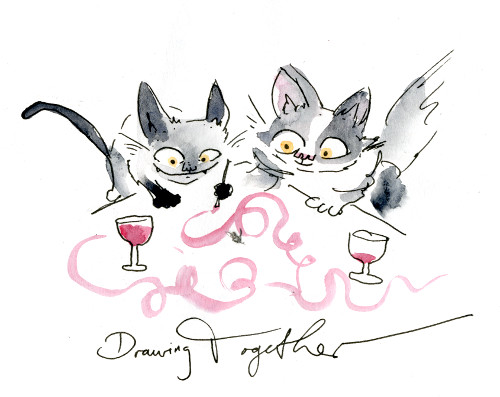
5. Jules: What is currently in rotation on your iPod or loaded in your CD player? Do you listen to music while you create books?
Viviane: I ask friends to send me songs and playlists while I work and am inking and colouring in the studio. I also found that a side of an LP record is a good amount of time to spend drawing before taking a tea break.
I often listen to music when I work — or to audio books. The unabridged Moby Dick as read by William Hootkins is my all-time favourite.

— From Alexis Deacon’s
A Place to Call Home (Candlewick, 2011)
(Click to enlarge spread)
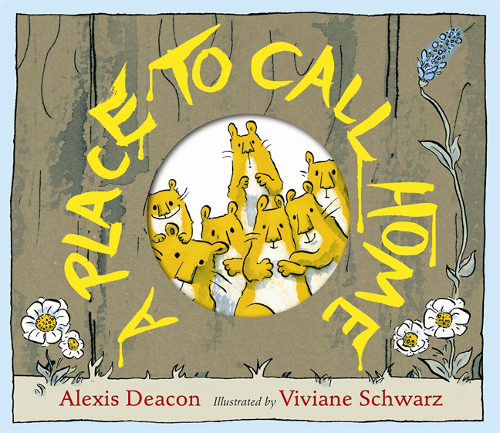
6. Jules: What’s one thing that most people don’t know about you?
Viviane: I was the German voice of Dazzle on the My Little Pony story tapes back in the early ’90s.
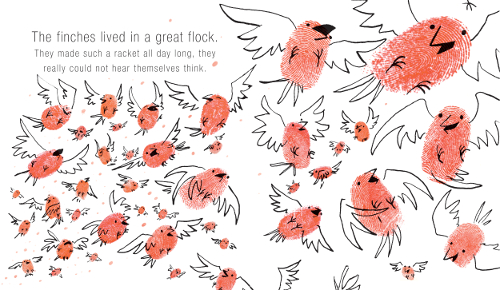
they really could not hear themselves think.”
(Click to enlarge spread)

(Click to enlarge spread)
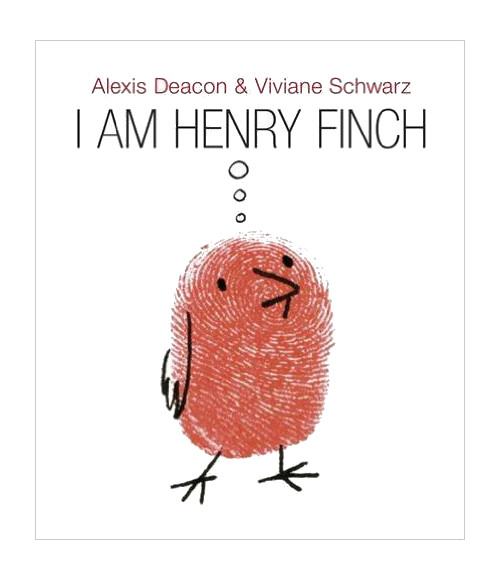
illustrated by Viviane (Candlewick, 2015)
7. Jules: Is there something you wish interviewers would ask you — but never do?
Viviane: I want them to ask me about the importance of love in my work. Then I want to say the important thing is that you don’t own people or things or places because you love them, but you own your love. No one else put it there. You cannot ever give it away; it’s not a currency. You can’t buy any rights with it. It’s like a light you carry inside yourself that might warm others or burn them, but it remains yours alone. Don’t try to give your love, but let it light your way and you will find what it is you need to give to those you love, and they might even love you at the same time until it’s hard to tell where it’s all coming from. Or they might not, and it doesn’t diminish what you have. That’s what I believe, and what I do with it is mostly … make books. That’s why I make books. But it’s not what I say when people ask. I say: Because I’m really good at it. Which is also a reason.
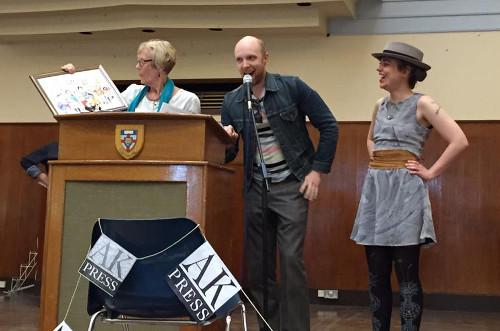
(Click to enlarge)

Jules: What is your favorite word?
Viviane: “Hey.”
Jules: What is your least favorite word?
Viviane: “Magic.”
Jules: What turns you on creatively, spiritually or emotionally?
Viviane: Kindness.
Jules: What turns you off?
Viviane: Bullies.
Jules: What is your favorite curse word? (optional)
Viviane: “Bullshit!”
Jules: What sound or noise do you love?
Viviane: Rain on a tent.
Jules: What sound or noise do you hate?
Viviane: Cat retching in the dark.
Jules: What profession other than your own would you like to attempt?
Viviane: I imagine it would be very satisfying to be a singer. If one were very good at it.
Jules: What profession would you not like to do?
Viviane: Underwater welder.
Jules: If Heaven exists, what would you like to hear God say when you arrive at the Pearly Gates?
Viviane: “Ah, good that you’re here.”
CHEESE BELONGS TO YOU! Text Copyright © 2013 by Alexis Deacon. Illustrations copyright © 2013 by Viviane Schwarz. Reproduced by permission of the publisher, Candlewick Press, Somerville, MA on behalf of Walker Books, London.
COUNTING WITH TINY CAT. Copyright © 2017 by Viviane Schwarz. Reproduced by permission of the publisher, Candlewick Press, Somerville, MA on behalf of Walker Books, London.
HOW TO FIND GOLD. Copyright © 2016 by Viviane Schwarz. Reproduced by permission of the publisher, Candlewick Press, Somerville, MA on behalf of Walker Books, London.
I AM HENRY FINCH. Copyright © 2014 by Viviane Schwarz. Reproduced by permission of the publisher, Candlewick Press, Somerville, MA on behalf of Walker Books, London.
IS THERE A DOG IN THIS BOOK? Text copyright © 2015 by Alexis Deacon. Illustrations copyright © 2015 by Viviane Schwarz. Reproduced by permission of the publisher, Candlewick Press, Somerville, MA on behalf of Walker Books, London.
A PLACE TO CALL HOME. Text copyright © 2011 by Alexis Deacon. Illustrations copyright © 2011 by Viviane Schwarz. Reproduced by permission of the publisher, Candlewick Press, Somerville, MA on behalf of Walker Books, London.
All other images used by permission of Viviane Schwarz.
The spiffy and slightly sinister gentleman introducing the Pivot Questionnaire is Alfred, copyright © 2009 Matt Phelan.

I’m such a huge fan of Viviane’s, this is like a little pot of gold on my desk. Love her art, her style, her humor. Thanks, you two.
I am just REELING at the profundity of her last thoughts – “…but you own your love. No one else put it there. You cannot ever give it away; it’s not a currency. You can’t buy any rights with it. It’s like a light you carry inside yourself that might warm others or burn them, but it remains yours alone.” I’m going to have to sit with that for a long while.
I love her artwork! She’s part Edward Gorey, part Quentin Blake, and all quirky original. Love it – this was great.
That was fantastic! Thank you Jules and Viviane. Now! If it would just stop raining, snowing and blowing, I would go outside and skip up and down the street for a bit!
Wunderbar! Loved hearing how Viviane has retained the same level of curiousity she displayed in her hometown library. Wish I could see that birdfoot brush!
Thanks for a fun and stirring interview. Love the art and learning more about Vivianne’s joyful, alive work!
Didn’t mean to misspell Viviane:sorry.
Love this interview. Thanks, Jules & Viviane. Makes me want to pop on over to London for a visit.
I did get to pop over to London and visit with Viv and it was such a pleasure. She’s a very unassuming creative genius. She is a real artist- she has made her whole life into an art form . I think it’s a form of bravery to be so authentic in the face of everything. Thanks Viv and Jules for this interview.